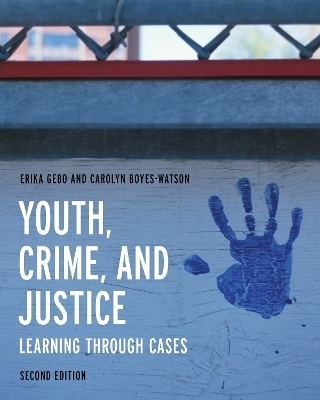
Youth, Crime, and Justice
Rowman & Littlefield (Verlag)
978-1-5381-6307-8 (ISBN)
The Learning Through Cases model offers students and instructors the pedagogical power of the narrative to frame the complex dynamics of the lives of diverse youth within families, communities, schools, child welfare, and juvenile justice systems. Each of the twelve chapters begins with a compelling case that illustrates the core sociological concepts, real life stories and dilemmas which frame the ongoing challenges of the societal institutions charged with meeting the needs of children and youth.
Erika Gebo is professor of sociology & criminal justice at Suffolk University. She is a co-editor of the book, Looking Beyond Suppression: Community Responses to Gang Violence. Carolyn Boyes-Watson is Professor of sociology & criminal justice and the Director for the Center for Restorative Justice at Suffolk University. She is the author of Crime and Justice: Learning through Cases and co-author of Circle Forward: Building a Restorative School Community.
Preface
Acknowledgments
PART I: FOUNDATIONS OF YOUTH, CRIME, AND JUSTICE
Chapter 1: Youth, Society, and the Law
Learning Objectives
Case Study 1: Judging Gina
Introduction
Juvenile Justice System Core Challenges
Socio-Ecology: Age in a Life Context
Social and Legal Constructions
Intersectionality
Positive Youth Development Lens
Key Terms
Chapter Questions & Discussions
Check it Out
Chapter 2: Youth and Developmental Institutions
Learning Objectives
Case Study 2: Saving or Exploiting Children?
Introduction
Decline of Family-Based Systems of Social Control
Emergence of Childhood
Industrialization, Urbanization, & Immigration
Emergence & Regulation of Adolescence
Institution Building Era
Controlling Adolescent Girls
Racial Segregation
Parens Patriae Legal Doctrine
Origins of Child Welfare
Juvenile Court Creation
Comparing Rhetoric with Reality
Key Terms
Chapter Questions & Discussions
Check it Out
Chapter 3: Paradigms of Youth Justice
Learning Objectives
Case Study 3: A Tragedy or a Crime?
Introduction
Juvenile Justice Cycles or Shifts?
The Classical Juvenile Justice Paradigm
The Juvenile Rights Paradigm
The “Get Tough” Paradigm
The Positive Youth Development & Community Restorative Justice Paradigm
Key Terms
Chapter Questions & Discussions
Check it Out
PART II: PATHWAYS TO CRIME FOR MALES AND FEMALES
Chapter 4: Measurement & Correlates of Youth Crime and Violence
Learning Objectives
Case Study 4: Not Just Another Statistic: The Hope of Tribal Justice for Indigenous Youth
Introduction
Measuring Delinquency
A Snapshot of Juvenile Crime
Juvenile Victimization
Adverse Childhood Experiences
Correlates of Violence
Key Terms
Chapter Questions & Discussions
Check it Out
Chapter 5: Delinquency, Victimization, and Pathways to Offending for Boys
Learning Objectives
Case Study 5: Learning the Code
Introduction
Theories of Delinquency
Person-Centered Theories
Society-Centered Theories
Integrated Theories
Critical Theories
Key Terms
Chapter Questions & Discussions
Check it Out
Chapter 6: Delinquency, Victimization, and Pathways to Offending for Girls
Learning Objectives
Case Study 6: Addicted to Love: Growing up on the Track
Introduction
Female Delinquency Recap
Feminist Perspectives on Gender & Justice
Female Pathways to Delinquency
Risk & Protective Factor Framework
Key Terms
Chapter Questions & Discussions
Check it Out
Chapter 7: Gangs & Serious, Violent, Chronic Offenders
Learning Objectives
Case Study 7: Confessions of a Former Latin King
Introduction
Understanding Gangs
Serious, Violent, and Chronic Offenders
Promising Innovations Addressing Gangs & SVC Offenders
Key Terms
Chapter Questions & Discussions
Check it Out
Chapter 8: Youth, Schools, & Problem Behaviors
Learning Objectives
Case Study 8: Mobilizing for Change: Youth Respond to School Gun Violence Introduction
Education and Inequality
School Crime
School Climate
Discipline & the School to Prison Pipeline
School Programs for Positive Change
Key Terms
Chapter Questions & Discussions
Check it Out
PART III: THE CONTEMPORARY JUVENILE JUSTICE SYSTEM
Chapter 9: Youth and Police
Learning Objectives
Case Study 9: Victor Rios Changing What Police See
Introduction
History of Policing Youth in America
Juvenile Justice System Case Flow
Police Role in Juvenile Justice
Police Discretion
Gender and Police Treatment
Policing Practices
Police and Civil Rights
Changing Role of Police
Key Terms
Chapter Questions & Discussions
Check it Out
Chapter 10: Youth and the Courts
Learning Objectives
Case Study 10: Judging Our Youth
Introduction
Juvenile Court Evolution
Juvenile Court Stages
Key Court Personnel
Court Practices & Effectiveness
Significant Juvenile Justice Cases
From Juvenile to Adult Court
Future of Juvenile Court
Key Terms
Chapter Questions & Discussions
Check it Out
Chapter 11: Youth and Corrections
Learning Objectives
Case Study 11: From Punishment to Rehabilitation
Introduction
Intervening With Youth
Diversion
Probation
Intermediate Sanctions
Residential Corrections
Key Issues in Residential Placement
Key Terms
Chapter Questions & Discussions
Check it Out
Chapter 12: Prevention, Intervention, and the Future of Youth Justice
Learning Objectives
Case Study 12: A Matter of Degrees
Introduction
Three Levels of Prevention
What Works
Evidence-Based Practices
Evidence-Based Programs
Comprehensive Community Initiatives
What Does Not Work
The Future of Youth & Juvenile Justice
Concluding Thoughts
Key Terms
Chapter Questions & Discussions
Check it Out
Glossary
Photo Credits
Index
About the Authors
| Erscheinungsdatum | 09.01.2023 |
|---|---|
| Reihe/Serie | Learning through Cases |
| Verlagsort | Lanham, MD |
| Sprache | englisch |
| Maße | 214 x 255 mm |
| Gewicht | 807 g |
| Themenwelt | Recht / Steuern ► EU / Internationales Recht |
| Recht / Steuern ► Strafrecht ► Besonderes Strafrecht | |
| Recht / Steuern ► Strafrecht ► Kriminologie | |
| ISBN-10 | 1-5381-6307-1 / 1538163071 |
| ISBN-13 | 978-1-5381-6307-8 / 9781538163078 |
| Zustand | Neuware |
| Haben Sie eine Frage zum Produkt? |
aus dem Bereich


